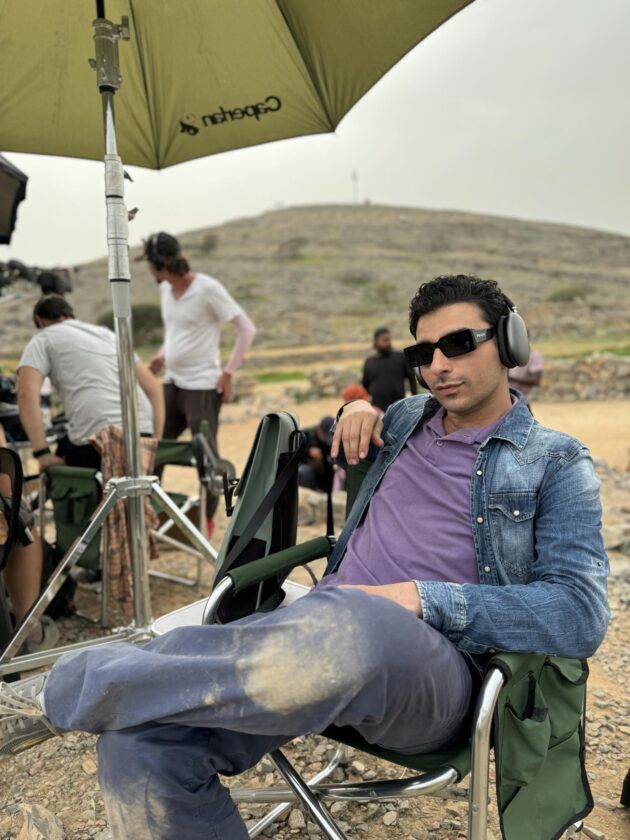The “Barker of Bardo,” a fictional persona created by Faten Rouissi, welcomes visitors to an exhibition of contemporary art.
While the Bardo National Museum usually greets visitors with mosaics on the walls of white-clad rooms, these days guests are greeted by a giant white statue with a muzzle strategically placed where the head should be, lit with a blue projector highlighting a card that reads: “The Barker of Bardo.”
Instead of the iconic mosaics, it is the “Barker of Bardo,” a fictional persona created by Faten Rouissi that welcomes visitors to an exhibition of contemporary art alongside iconic pieces and historical artefacts of the museum. Rouissi’s exhibition invites viewers to revisit the history and heritage of the museum.
“The Barker of Bardo,” running through April 12, showcases multidisciplinary installations ranging from paintings to sound featuring the muzzle as a motif. For Rouissi, the character of the Barker is inevitable in the context of new democracies in which debates and arguments are often heated.
“The fictional character of the Barker of Bardo came as a reaction to the cacophony of sounds and the noise in the media and in the streets after the revolution,” Rouissi said. “It was hard to listen to what we are saying and that resulted in miscommunication.
“In a new democracy, all the rising voices were speaking together in the media and in the daily discourse resulting in chaos and dissonance. No one could understand what the other was saying.”
The exhibition features installations in the main rooms of the museum with reference to historical figures, such as the painting that features a meeting between the Barker and the poet Virgil.
Each work in the exhibition explores an aspect of the value of dialogue and Rouissi’s use of muzzles in each piece sparked questions.
“Despite the fact that the muzzle looks like a tool of oppression, it becomes an image and a metaphor on the artistic level. I focus on the symbolic value of this instrument, which is used in my work as a tool of moderation. It becomes like the thread weaving all these pieces together,” Rouissi explained.
“Muzzles usually instil fear and evoke violence but here it is like the right balance. The muzzle can be considered as a measuring tool to reduce the intensity of communication so that we hear each other. It becomes an instrument of equilibrium to appease the cacophony and acquires a symbolic value to explore.”
As museum visitors discover the rooms exhibiting Roman, Punic and other artefacts, they also explore the evolution of the Barker through the installations, which emphasise dialogue and encourage the viewer to rediscover the historical heritage of Tunisia contrasted with contemporary art.
As the muzzle symbolises the artist’s call to cherish communication and dialogue, the setting of the exhibition highlights the need for dialogue between historical pieces and the art exhibition.
“It is an initiative to promote contemporary art in relation to history and to build a bridge between art and the history,” Rouissi said. “The idea is to include these elements of contemporary art in the rooms of the museum and to open it for the visitors to reflect on them. The aim is to invite the spectator to reflect on the relationship between art, history and academia.”
She added: “It is an opportunity to visit the art gallery and understand contemporary art in the context of history since the persona of the Barker interacts with the mosaics and with the historical figures of the exhibition. Many people will discover history in a new light with these elements of the exhibition contrasted with historical artefacts. We used light, mapping to emphasise the history of the place.”
Rouissi also said art and history should be explored together — not separately — because art brings new perspective to reading history.
“Museums should be alive and vibrant with art and colours to showcase our heritage. The point is that the heritage should be explored through contemporary art and to highlight the site that is at the heart of history,” Rouissi said.
“We definitely need to explore these multidisciplinary art techniques to create a bridge between youth who use a lot of digital techniques and historical heritage of our country.”
Rouissi draws attention to the urgent need for change in Tunisia’s cultural policy as the exhibition will draw younger generations to revisit their historical heritage.
“Economy cannot happen until there is a strong link established between art and culture and economy. Culture can have a solid effect that can be as strong as politics and economy. However, to be influential, the cultural industry needs to have a strong mechanism and have strong structures,” Rouissi said
Not only does the exhibition showcase contemporary art in relation to history, it also seeks to send a message of hope in a country where religious extremism has targeted culture and art. The exhibition opened the week before the anniversary of the terrorist attack on the museum on March 18, 2015, in which 21 people, mostly foreign tourists, were killed. Rouissi said she chose the date to honour the memory of those killed in the attack.
“I wanted to have my exhibition in March because this month marks a painful memory for Tunisians and the family of the victims,” she said. “It is an invitation to people to reflect on the role of art in fighting extremism and it is to send a message to the world. We cannot make progress and fight the darkness of radicalism without art and without beauty. People need to learn to realise the importance of dialogue with each other.”
She added: “Three years after the painful attack, here we are at the Bardo Museum talking about art and celebrating culture and that is a step forward. It is a message to the terrorists, a message of resistance. We are here, still standing and showcasing the beauty of this place and of our history despite all the pain.”
Roua Khlifi a regular Travel and Culture contributor in Tunis.




